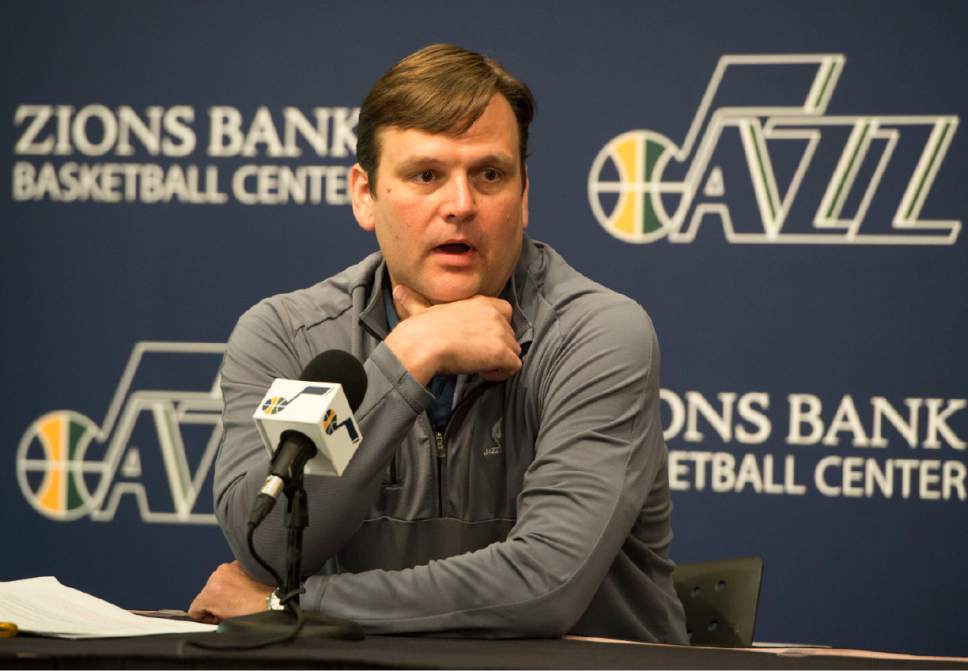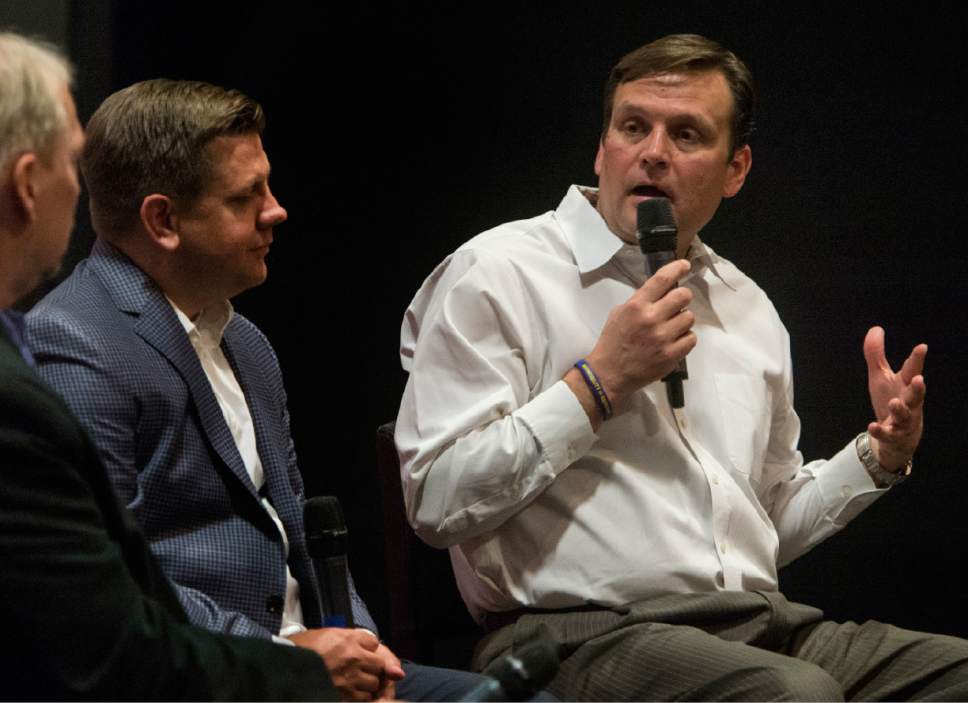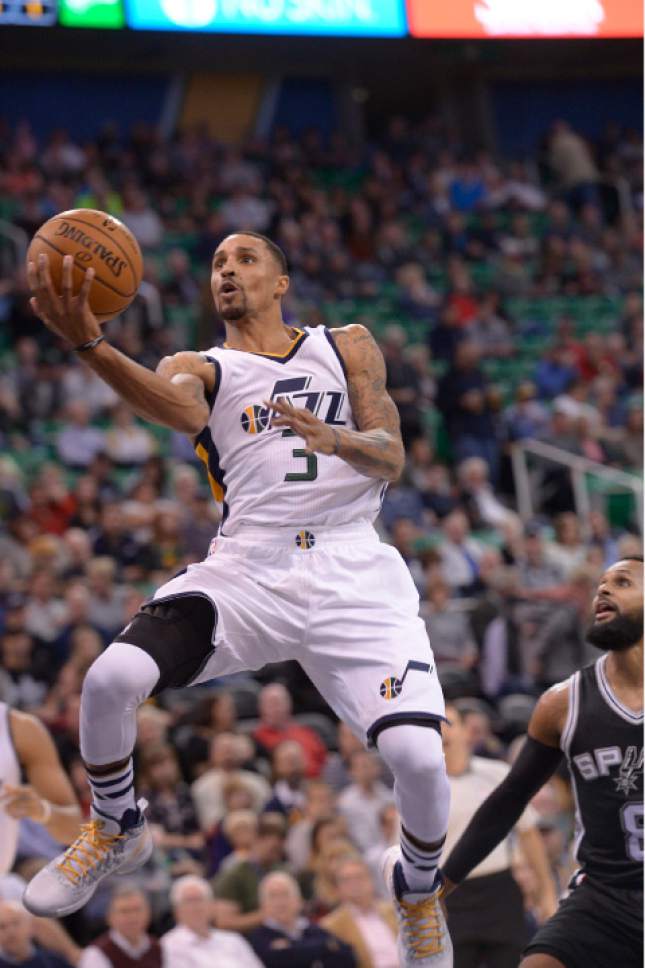This is an archived article that was published on sltrib.com in 2017, and information in the article may be outdated. It is provided only for personal research purposes and may not be reprinted.
Before the architect could build something new, he wanted to pretty much blow the whole thing up.
"I wasn't part of 25," Dennis Lindsey said this week. "I was the cause of 25."
Twenty-five, for those who have tried to block out the memories, refers to the number of wins Gordon Hayward and company struggled to muster together in 2013-14, the season after Lindsey decided being average wasn't enough. Instead, the Jazz's general manager wanted to clean house, building on a stockpile of young talent and draft picks, in hopes of putting together an honest to goodness contender.
Four seasons later, with plenty of metaphorical pencil marks and eraser shavings on his blueprint, Lindsey's squad is about to embark on the phase of that plan: the team's first trip to the postseason since 2012.
How did they get here?
The Ask
He needed $3 million and the clock was ticking.
On draft night, June of 2013, Lindsey had made a deal that would eventually turn into a flop, trading two first-round picks to move up to grab point guard Trey Burke out of Michigan. But with some help from his mentor, the new general manager would redeem himself in a big way.
A young center from France had fallen in the draft and, with the blessing and cash from Jazz ownership, Lindsey could buy back into the first round to get him. He turned to the guy whose job he was taking for help.
Lindsey gives former Jazz general manager Kevin O'Connor plenty of credit. O'Connor drafted Hayward, obtained Derrick Favors in the Deron Williams trade with New Jersey and strategically stacked the Jazz's contracts so that most would expire at the same time, giving Lindsey a chance to realize his vision.
"Look, if I was in your seat, I couldn't do this," Lindsey recalled O'Connor telling him. "I couldn't intentionally rebuild. But I'm telling you it's the right thing to do."
And when Lindsey asked for money on that night in 2013, O'Connor got the Miller family's approval to swing the deal that would land the Jazz a future Defensive Player of the Year candidate.
"Rudy Gobert is not here today unless Kevin O'Connor is part of our organization," Lindsey said. "Greg and Steve Miller didn't know me and I was asking them to do something they had never done before because I really wanted the guy. Kevin was able to saddle up and explain the rationale why. Thank the Lord he was in the room."
The Kid
The first time Jazz fans heard his name called they booed.
But that's not the only thing Lindsey thinks Hayward has in common with John Stockton.
It took the Hall of Fame point guard five seasons to become a starter in Utah, and Lindsey sees some of the same things now in Hayward, whom Jazz officials threw into the fire four years ago and have watched emerge as an All-Star ready to lead his team into the playoffs.
"There's a similar path," Lindsey said.
Hayward was a kid with a mop-top when the Jazz turned over the keys to the franchise. That season, with Hayward as the team's No. 1 option, the Jazz won those 25 measly games.
Over each of the next three years, Hayward would up his scoring — and the Jazz's win totals — averaging 22 points per game this season to get his team back to playing basketball past mid-April.
"I was hoping it would happen quicker, to be honest," Hayward said of the Jazz's ascension and path back to the playoffs. "[But] I think we've gotten better each year, which has been kind of the fun part of being on this team, to grow internally, for the most part, with guys getting better each year. … I think the cool thing about us is guys have a lot of room to improve and we can still get a lot better. So that's the exciting part."
The Coach
Like Hayward, Derrick Favors remembers the pain of those early losses well.
"It was tough, man," he said. "It was tough."
With that perspective, the power forward can identify a clear turning point in the franchise's fortunes.
"When Quin got here," Favors said. "He brought in a new game plan."
Under Quin Snyder, the Jazz have improved from a 25-win team in 2013-14 to a squad that has won 38, 40 and now 50 wins in the past three seasons, respectively.
"We didn't discuss [a timeline for getting back to the playoffs] per se," Snyder said, reflecting back on his first interviews with Lindsey and the Millers in 2014. "More than anything, the challenge for me when I took the job, in my mind, was development of the team."
With a penchant for Xs and Os and a dedication to player development, Snyder has helped turn the Jazz into one of NBA's stingiest defensive units (third-best overall), while helping transform Hayward and Gobert into All-NBA candidates. That, while dealing with an injury depleted squad for most of the season, should be enough to earn him some Coach of the Year votes.
"Quin's done an unbelievable job to get us to 50 given what's happened," Lindsey said.
The Vets
This time last year, the lockers in Vivint Smart Home Arena had been cleared out, and Lindsey couldn't help but feel responsible.
The Jazz had missed out on the postseason, despite an injury-plagued season that saw Gobert, Favors and Alec Burks all miss substantial time.
"To be honest, last year was a disappointment," Lindsey said. "There were more wins on the table. … Frankly, that was on me, our lack of experience and lack of depth. We needed to add to the group."
Enter George Hill, Joe Johnson and Boris Diaw: a combined 36 seasons of NBA experience.
Lindsey could be in line for an Executive of the Year honor for his summertime acquisitions, turning a late lottery pick into Hill, a starting point guard who has averaged a career-high 17 points per game when healthy, and turning a former second-round pick into the playmaking big man Diaw.
At the waiver deadline last season, Lindsey had reached out to Johnson. Ultimately, Johnson chose to go to Miami to finish the season, but the Jazz GM had been able to plant the seeds that would bring Johnson to Utah come summer.
"We added the guys that we added this year and they made a huge impact on our team's success," Hayward said, "and here we are."
Twitter: @aaronfalk —
How the Jazz were rebuilt
May 7, 2012 — Jazz are swept out of the first round of the playoffs by the San Antonio Spurs.
Sept. 1, 2012 — Dennis Lindsey hired as general manager.
June 27, 2013 — After moving up to select point guard Trey Burke with the ninth pick of the draft, the Jazz traded back into the first round to grab center Rudy Gobert out of France.
July 1, 2013 — Free agency begins, Lindsey would let veterans Paul Millsap, Al Jefferson and DeMarre Carroll leave Utah, starting a period of rebuilding for the franchise.
April 16, 2014 — Gordon Hayward's first season as the Jazz's top scoring option ends with the team winning just 25 games.
April 21, 2014 — Jazz announce Ty Corbin will not return as head coach.
June 6, 2014 — Quin Snyder hired as the team's next head coach.
Feb. 19, 2015 — The Jazz trade disgruntled big man Enes Kanter to Oklahoma City, opening up a spot in the starting lineup for Gobert.
April 13, 2016 — Utah loses four of its final five games of the season and is eliminated from playoff contention on the final night of the regular season.
Oct. 31, 2016 — Gobert signs a four-year contract extension worth over $100 million.
Jan. 26, 2017 — For the first time in his career, Hayward is named to the Western Conference's all-star team.
April 12, 2017 — Jazz beat the San Antonio Spurs for their 51st win of the season, the franchise's best campaign since 2009-10, and head into the playoffs of the fifth-seed in the West.











